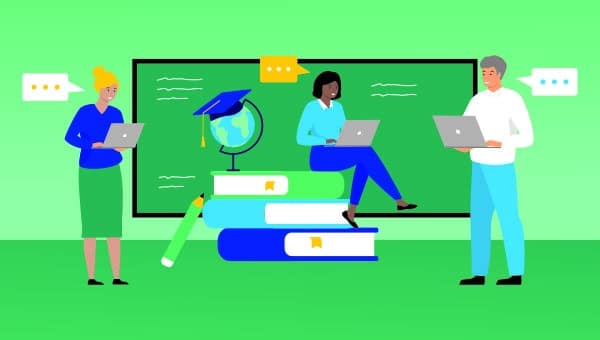How to Build a Digital PR Campaign for Faculty
When you’re in the higher education space, you’ll inevitably hit a roadblock at some point. Maybe your competitor schools achieve higher application rates, star in more news stories, or receive more donor funding. Or maybe they simply have higher levels of faculty engagement, thus making their overall public relations more effective than yours.
It may sound simple, but faculty participation is a PR hack too many colleges and universities forget to employ. That’s why the Archer Education PR team put together a free webinar to show you there’s a way forward with public relations in higher education. It starts with harnessing the power of your faculty. You can watch it here.
In case you’re short on time, though, we’ve condensed the key points for you below.
What Is Digital PR?
As its name suggests, digital PR differs from traditional PR in that it’s done online. This practice is especially necessary today when nearly every college-bound student has access to the internet and spends much of their time online. So how are digital PR strategies different from traditional strategies?
First, digital PR drives overall brand awareness for your school differently from typical press releases, which tend to have a word limit and focus on one key topic. Digital methods have no such boundaries. You can speak on any topic at any length, and you can also use SEO tactics to ensure more people within your target audience actually read what you’ve shared.
Second, digital PR provides you with greater control over your school’s overall narrative. As a higher education public relations representative, you can take a more proactive approach to storytelling, rather than the reactive approach that characterizes traditional PR. Digital PR differs from traditional strategies in many other ways, including the ability to turn offline experts into online authorities and the opportunity to build high-quality backlinks. Digital PR can also help schools meet key performance indicators (KPIs) and bring in a high return on investment (ROI) of marketing, which we’ll be discussing in the next section.
How Does Digital PR Contribute to Marketing ROI?
Like traditional PR, digital PR helps higher education institutions meet, and even exceed, their marketing goals. Unlike traditional PR, however, it does so in four distinct ways:
- Brand awareness
- Thought leadership
- Organic traffic
- Visibility and rankings
Brand Awareness
One of the main ways digital PR helps higher education institutions meet marketing ROI goals is through brand awareness. Earlier, we mentioned the difference between press releases and online content. Let’s revisit that. Online content gives you the ability to feature your school and programs much more broadly compared with traditional press releases. You can discuss more topics and address more questions that prospective students may have.
In effect, online content increases the number of potential touchpoints your institution has with prospective students. And when that content performs well, it also increases your chances of being featured in major outlets without having to pay the exorbitant rates you would with traditional PR in education.
Thought Leadership
Online content and PR can further increase your marketing ROI with the propensity to inspire thought leadership. This is where the aforementioned faculty participation comes into play.
When you feature faculty members or get national or industry publications to quote them, you’re able to position them as leaders and trusted sources in their areas of expertise. This has a twofold effect of improving a faculty member’s position in their industry and improving the draw of your institution for prospective students interested in that faculty member’s area of expertise.
Organic Traffic
The more industries and niches your college or university develops content around, the more prospective students and families you’ll attract. Why? Students often choose to attend the college or university that will take them further along a desired career path, and your content is among the first things they look at when scouting schools.
Furthermore, when prospective students see that a respected thought leader works at your school, they’re more likely to be interested in learning more about you in exchange for the prospect of learning from that individual. PR in higher education can have a powerful ripple effect.
Visibility and Rankings
The fourth unique way digital PR can help you meet or even exceed your desired marketing ROI is through visibility and rankings. Search engines such as Google pay attention to both the content your institution puts out and the content that links back to you. When that content is high quality and comes from high-quality sources (Huffington Post, Washington Post, etc.), search engines view your institution as high quality and give it more visibility and higher rankings in search results.
PR in Education: Steps to Building a Digital PR Campaign
With all that being said, you’re likely wondering what you can do to help your institution reap some of the benefits of digital public relations in higher education. The following steps will help you get started.
Identify Faculty Members Who Will Participate
The first thing you need to do is talk with your faculty members. Gather intel on who would be interested in establishing themselves as industry experts, as well as their areas of expertise. This information will help you determine what topics to write about and what publications to reach out to about faculty features.
Conduct Introductory Faculty Interviews and Media Training
It’s not enough to simply ask your faculty members to start writing content and sharing their thoughts in national and industry publications. You also need to prepare them, since many will likely not have experience with PR in higher education. Introductory faculty interviews are a great way to do this since they give faculty members a taste of what they can expect moving forward with their thought leadership.
Here are some tips to help you conduct these interviews, regardless of whether you have past journalism experience:
- Research your faculty members and the questions you want to ask them beforehand, but don’t forget to also focus on each individual’s passions and expertise.
- Prepare for each interview like a reporter, but make it casual. Don’t focus too much on getting to each of your questions. As any good reporter knows, the flow of your conversation is also important.
- Ensure each faculty member has a thorough understanding of the interview process and media timelines.
- Execute both group and individual media training sessions. Doing this will prepare your faculty for both types of interviews.
- Encourage faculty members to answer only media questions that they’re comfortable answering.
- Once you start getting interviews set up with top publications, be sure to provide your faculty members with in-depth information on the people with whom they’ll be speaking.
Begin Pitching Faculty to the Media
Once you’ve prepared your faculty members for interviews and other methods of content creation, you can begin pitching their expertise to members of the media. A well-structured media pitch contains the following elements:
- A well-thought-out lede
- A call to action (CTA)
- A value proposition (why your faculty member should be chosen over other experts)
- A conclusion
- Personalization wherever possible
You’ll also want to research the recipients of your pitches ahead of time, as well as utilize a distribution and list-building service such as Cision or Muck Rack to streamline the outreach process. Check out our comprehensive beginner’s guide to Cision for tips and strategies if you’re new to higher education public relations. We also recommend looking into services such as HARO and Qwoted to find journalists and members of the media who are seeking to discuss your target topics. From there, pitching your faculty members and booking interviews for them is simply a matter of following up with media members who don’t respond within the first few days.
Facilitate the Created Media Opportunity
At this point in the higher-ed PR process, you’ve likely received at least one yes from a member of the media and have scheduled at least one interview. Now it’s time to facilitate the opportunity you’ve created and make the process as easy as possible for your faculty member. This means being present for the interview (if there is one), providing copy editing for email questions and responses, and laying out extensive editorial guidelines for byline publications.
Review and Maintain Communication With the Reporter/Editor
Completing the interview doesn’t mean your work is done. In fact, it’s just the beginning. Your job as a higher education PR manager is to maintain the relationship you’ve established with the media member up to, and even following, the publication of your faculty member’s interview or byline.
The next step entails contacting the reporter via email to provide them with your faculty member’s information and the link to your school’s program page or the faculty member’s bio page. This part is crucial, as it serves as the much-needed backlink to boost your rankings and visibility. From there, maintain your communication with the reporter until their article goes live; then, continue to nurture your relationship with them for potential interviews in the future.
Repeat (Build Genuine Relationships)
One thing to keep in mind when maintaining relationships with these reporters is that they need to be true relationships. Reporters are people too, and no PR manager has achieved long-term success by simply using people for their own needs. In fact, a reporter is often likely to reach out to the person they have the best, most genuine relationship with regarding a story — not someone they felt was only using them for their own gains.
Leverage Media Tracking and Metrics
No matter what direction your higher-ed PR strategy takes, it’s important that you keep careful track of your metrics and the impact your media bylines and interviews can have on your bottom line. At Archer Education, we do this in three main ways.
- Domain rating (DR). DR is based on a scale of 1-100 and indicates the influence a website will have on search engine optimization (SEO) when a backlink is included.
- Unique visitors per month (UVPM). UVPM measures the number of visitors that a website receives in a given month. We use the PR and earned media software Cision to pull this number.
Ad/publicity value. This number, which we use Cision to pull, displays how much a placement would cost if it were paid media as opposed to earned media.
Taking Your Faculty Engagement Beyond Media Relations
When you’re caught up in the whirlwind of setting up interviews for your faculty members, it can be easy to forget that those interviews don’t have to be a one-and-done deal. Instead, you can repurpose them to develop budget-friendly articles, profiles, and blog posts that promote your institution even more. You can even take to social media platforms such as Facebook and Twitter to share the unique content your faculty members have been a part of.
The Impact of Digital PR in Higher Education
Now that you’ve read through this guide, you’re significantly more prepared for digital PR success than many higher education institutions. In fact, digital PR with a focus on individual faculty members can, and often does, have a higher impact on school admissions than you may have thought. All you need to do to succeed is to keep the following key points in mind:
- Embrace the news cycle and the benefits it can bring you in the form of online engagement.
- Engage with your faculty members and use their expertise to your (and their) advantage through media relationships.
- Keep track of marketing metrics for each byline or mention your institution or individual faculty members receive.
And that’s it! You’re now well on your way to building a successful, ROI-driven online PR strategy that rivals the efforts of the highest-performing schools in the country. Good luck, and if you have any questions about implementing any of these suggestions, send us a message. We’ve helped hundreds of higher education institutions like yours hit their KPIs out of the ballpark, and we’re always excited to help more.



